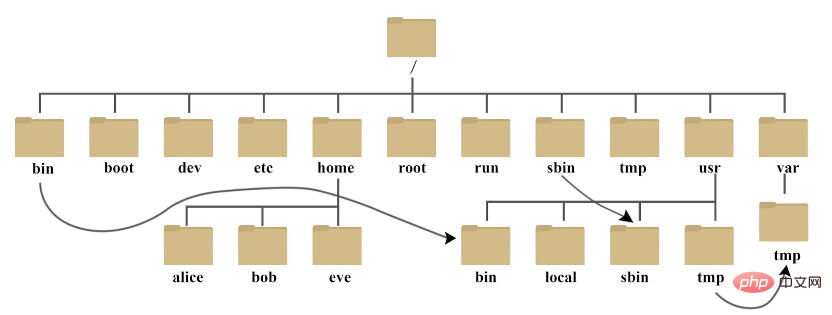Where is the etc directory in linux?
In Linux, the location of the etc directory is in the main directory, that is, "/etc"; etc is the abbreviation of Etcetera, which means "and so on", and is used to store all the information needed for system management. Configuration files and subdirectories, basically hardware and software configuration files are in this directory.

#The operating environment of this tutorial: linux7.3 system, Dell G3 computer.
Where is the etc directory in Linux
In Linux, the location of the etc directory is in the main directory

After logging in to the system, enter the command in the current command window:
ls /
The output results are as follows:

/etc:
etc is the abbreviation of Etcetera (etc.). This directory is used to store all configuration files and subdirectories required for system management.
For example, /etc/passwd is the system user configuration file, /etc/group is the user group configuration file, /etc/xinetd.conf is the configuration file of the xinetd service, and /etc/resolv.conf is used to specify The DNS server address of this machine, etc.
By editing these files, you can change and manage the system.
Extended knowledge
/etc directory is generally used to store the configuration files of the entire file system required by the program.
/etc directory
Contains many files. Many network configuration files are also in /etc.
/etc/rc or/etc/rc.d or/etc/ rc*.d
Scripts or directories of scripts that are run when starting or changing run levels.
/etc/passwd
User A database whose fields give the username, real name, home directory, encrypted password, and other information about the user.
/etc/fdprm
Floppy disk parameters Table. Describes different floppy disk formats. Set with setfdprm.
/etc/fstab
Mount -a command at startup (in /etc/rc or equivalent Startup file) list of automatically mounted file systems. Under Linux, it also includes information about the swap area enabled with swapon -a.
/etc/group
Similar /etc/passwd, but the description is not the user but the group.
/etc/inittab
init configuration file.
/etc/issue
The output information of getty before the login prompt. Usually includes a short description or welcome message of the system. The content is determined by the system administrator.
/etc/magic
file configuration file. Contains instructions for different file formats, file guesses the file type based on it.
/etc/motd
Message Of TheDay, automatically output after successful login. The content is determined by the system administrator. It is often used for notification information, such as warnings about planned shutdown time.
/etc/mtab
List of currently installed file systems. Initialized by scripts and automatically updated by the mount command. Used when a list of currently installed file systems is required, such as the df command.
/ etc/shadow
Shadow password file on a system with shadow password software installed. The shadow password file moves the encrypted passwords in the /etc/passwd file to /etc/shadow, which only Readable by root. This makes deciphering passwords more difficult.
/etc/login.defs
Configuration file for the login command.
/etc/printcap
Similar to /etc/termcap, but for printers. The syntax is different.
/etc/profile, /etc/csh.login,/etc /csh.cshrc
File executed by Bourne or Cshells at login or startup. This allows system administrators to establish a global default environment for all users.
/etc/ securetty
Confirm the secure terminal, that is, which terminal allows root login. Usually only the virtual console is listed, so that it is impossible (at least difficult) to break into the system via modem or network and obtain superuser privileges .
/etc/shells
List the trusted shells. The chsh command allows users to change the login shell within the scope specified in this file. Provides FTP service for a machine The service process ftpd checks whether the user shell is listed in the /etc/shells file. If not, the user will not be allowed to log in.
Recommended learning:Linux video tutorial
The above is the detailed content of Where is the etc directory in linux?. For more information, please follow other related articles on the PHP Chinese website!

Hot AI Tools

Undresser.AI Undress
AI-powered app for creating realistic nude photos

AI Clothes Remover
Online AI tool for removing clothes from photos.

Undress AI Tool
Undress images for free

Clothoff.io
AI clothes remover

Video Face Swap
Swap faces in any video effortlessly with our completely free AI face swap tool!

Hot Article

Hot Tools

Notepad++7.3.1
Easy-to-use and free code editor

SublimeText3 Chinese version
Chinese version, very easy to use

Zend Studio 13.0.1
Powerful PHP integrated development environment

Dreamweaver CS6
Visual web development tools

SublimeText3 Mac version
God-level code editing software (SublimeText3)

Hot Topics
 1393
1393
 52
52
 37
37
 110
110
 What computer configuration is required for vscode
Apr 15, 2025 pm 09:48 PM
What computer configuration is required for vscode
Apr 15, 2025 pm 09:48 PM
VS Code system requirements: Operating system: Windows 10 and above, macOS 10.12 and above, Linux distribution processor: minimum 1.6 GHz, recommended 2.0 GHz and above memory: minimum 512 MB, recommended 4 GB and above storage space: minimum 250 MB, recommended 1 GB and above other requirements: stable network connection, Xorg/Wayland (Linux)
 vscode cannot install extension
Apr 15, 2025 pm 07:18 PM
vscode cannot install extension
Apr 15, 2025 pm 07:18 PM
The reasons for the installation of VS Code extensions may be: network instability, insufficient permissions, system compatibility issues, VS Code version is too old, antivirus software or firewall interference. By checking network connections, permissions, log files, updating VS Code, disabling security software, and restarting VS Code or computers, you can gradually troubleshoot and resolve issues.
 Can vscode be used for mac
Apr 15, 2025 pm 07:36 PM
Can vscode be used for mac
Apr 15, 2025 pm 07:36 PM
VS Code is available on Mac. It has powerful extensions, Git integration, terminal and debugger, and also offers a wealth of setup options. However, for particularly large projects or highly professional development, VS Code may have performance or functional limitations.
 What is vscode What is vscode for?
Apr 15, 2025 pm 06:45 PM
What is vscode What is vscode for?
Apr 15, 2025 pm 06:45 PM
VS Code is the full name Visual Studio Code, which is a free and open source cross-platform code editor and development environment developed by Microsoft. It supports a wide range of programming languages and provides syntax highlighting, code automatic completion, code snippets and smart prompts to improve development efficiency. Through a rich extension ecosystem, users can add extensions to specific needs and languages, such as debuggers, code formatting tools, and Git integrations. VS Code also includes an intuitive debugger that helps quickly find and resolve bugs in your code.
 How to use VSCode
Apr 15, 2025 pm 11:21 PM
How to use VSCode
Apr 15, 2025 pm 11:21 PM
Visual Studio Code (VSCode) is a cross-platform, open source and free code editor developed by Microsoft. It is known for its lightweight, scalability and support for a wide range of programming languages. To install VSCode, please visit the official website to download and run the installer. When using VSCode, you can create new projects, edit code, debug code, navigate projects, expand VSCode, and manage settings. VSCode is available for Windows, macOS, and Linux, supports multiple programming languages and provides various extensions through Marketplace. Its advantages include lightweight, scalability, extensive language support, rich features and version
 How to run java code in notepad
Apr 16, 2025 pm 07:39 PM
How to run java code in notepad
Apr 16, 2025 pm 07:39 PM
Although Notepad cannot run Java code directly, it can be achieved by using other tools: using the command line compiler (javac) to generate a bytecode file (filename.class). Use the Java interpreter (java) to interpret bytecode, execute the code, and output the result.
 What is the main purpose of Linux?
Apr 16, 2025 am 12:19 AM
What is the main purpose of Linux?
Apr 16, 2025 am 12:19 AM
The main uses of Linux include: 1. Server operating system, 2. Embedded system, 3. Desktop operating system, 4. Development and testing environment. Linux excels in these areas, providing stability, security and efficient development tools.
 How to check the warehouse address of git
Apr 17, 2025 pm 01:54 PM
How to check the warehouse address of git
Apr 17, 2025 pm 01:54 PM
To view the Git repository address, perform the following steps: 1. Open the command line and navigate to the repository directory; 2. Run the "git remote -v" command; 3. View the repository name in the output and its corresponding address.




